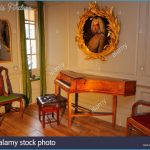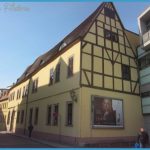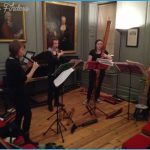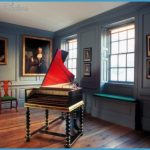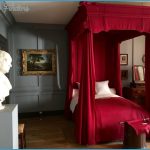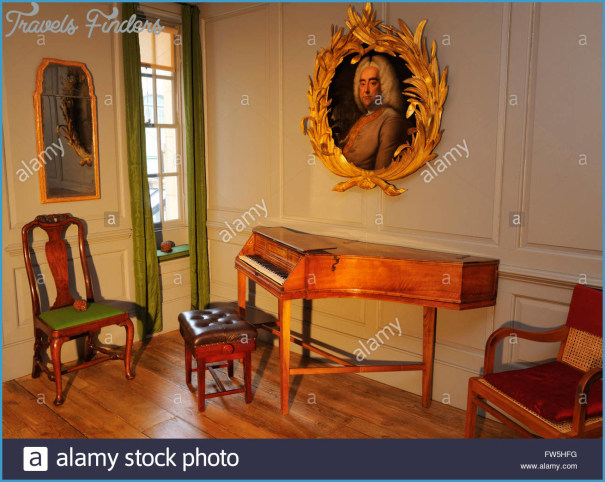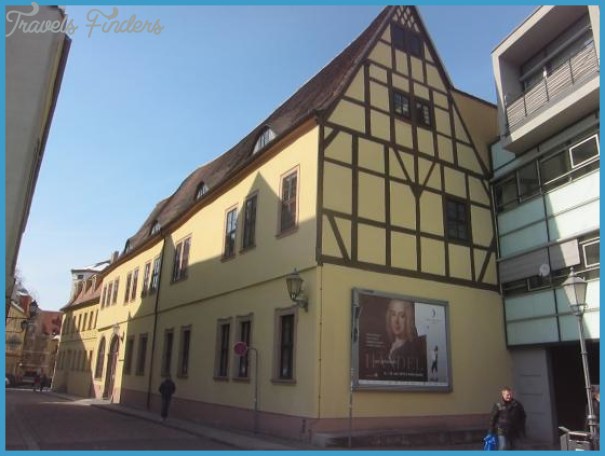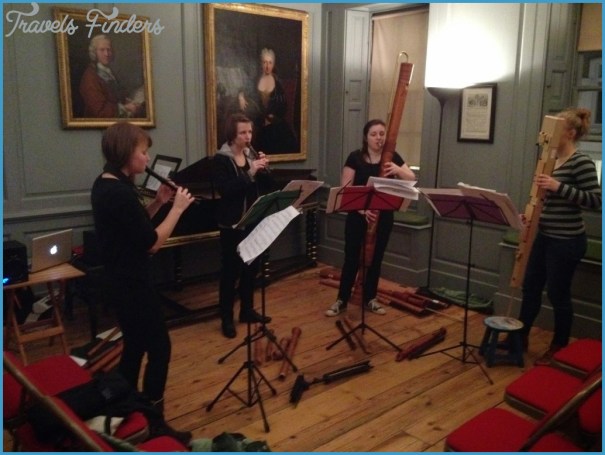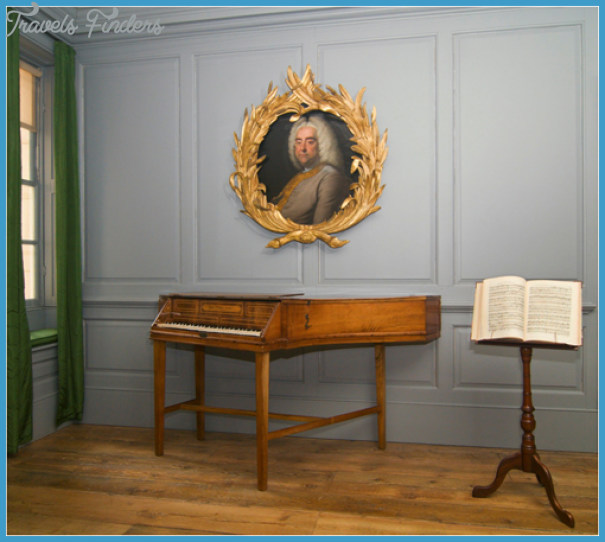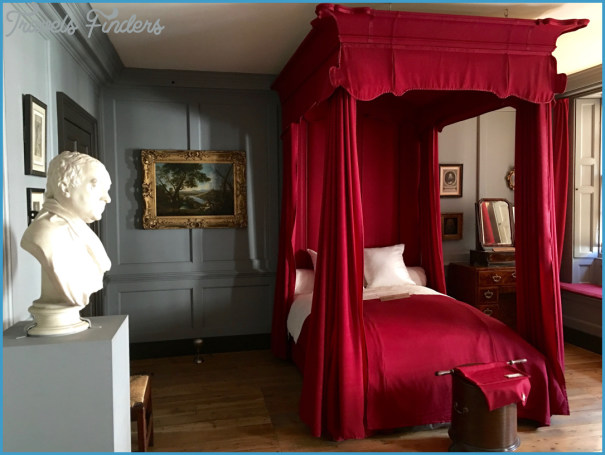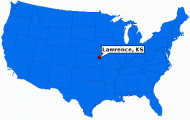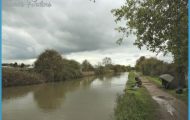HANDEL MUSEUM
The large middle-class house at the sign of the Yellow Stag’ in Halle, behind the Liebfrauenkirche, close to where George Frideric Handel was born on 23 February 1685, has been a museum for more than 50 years. After World War I, efforts were made by the Handelverein to acquire it, but the price proved beyond their reach. The English Handelian Newman Flower also tried unsuccessfully to wrest it from private hands. It was eventually taken over by the City of Halle in 1937, but was left unoccupied during World War II and required considerable renovation before it was opened to the public, as a civic museum, in 1948. The original museum was in fact in the house next to that of Handel’s birth, but it was subsequently enlarged and now occupies both and indeed other adjacent property too. In recent excavations of the basement it was found that it incorporated structures dating back to Roman times.
It is a remarkable institution, documenting not only Halle’s greatest composer but also the musical history of The Handelhaus, Halle the city through the lives and works of other prominent local musical figures -among them Samuel Scheidt, W.F. Bach, D.G. Turk, J.F. Reichardt, C.F. Loewe and Robert Franz (see separate entries) – and housing the city’s large and finely displayed collection of instruments as well as offices from which scholarly literature on Handel is produced. There is also an archive of the papers of the 19th-century Handel scholar and editor Friedrich Chrysander. From the time of its inauguration as a museum it has served as host to concerts of chamber music, which since 1952 have fallen into a regular pattern of weekly concerts and a substantial contribution to the Halle Handel-Festspiele in June.
The bicentenary of Handel’s death in 1959 and the tercentenary of his birth in 1985 provided impetus for further improvements to the facilities and the displays. In the 1950s a single room was equipped with a tape recorder to enable visitors to hear Handel’s music, and in the 1960s a taped guide to the collection was made available with commentary in two dozen languages. Today the museum boasts an integrated sound system and a studio used for rehearsals and recordings. Recorded music, carefully chosen, supplements the displays in the dozen rooms, which are chronologically organized to tell the story of Handel’s life in a fairly traditional style, with a rich and evocative array of reproductions, pictorial and musical, and copies of early printed material, along with furniture of the period. The rooms carry you from his early days in Halle, through his years in Hamburg and Italy and on to his lengthy London career, his burial in Westminster Abbey and his posthumous reputation and establishment as an icon.
HANDEL MUSEUM Photo Gallery
The City of Halle has gradually acquired the surrounding half-timbered buildings and refurbished them as a library, a keyboard restoration workshop, offices and public meeting rooms where weddings and other civil ceremonies regularly take place. The concert hall, now seating 120, opens out on to an attractive courtyard, used during the summer months to supplement the restaurant in the basement (under the Roman arches) which, serving local wines, now occupies the space where Handel’s father once purveyed wine; it is often the scene for public lectures and evening study sessions. If Handel’s birthplace no longer resembles his family home, it is at least alive with his memory and with music-making. Nearby, the large statue of Handel presiding over the marketplace, put up for the 1859 centenary with support from Queen Victoria among others, has become something of a symbol for the city.
In the 1930s Newman Flower also tried to acquire Handel’s London house, now 25 Brook Street, Mayfair, for a museum, and he failed there too. The area where Handel lived, then a new middle-class development, had over the years become one of the most desirable’ commercial parts of the West End, close to Bond Street and the busiest part of Oxford Street. So the value of the property put it beyond reach. It was not until the 1990s, with the redevelopment of the area by the Co-operative Insurance Society, which had acquired most of the nearby property, that opportunity arose to reclaim the house on Handel’s behalf. Originally it had been intended to create a museum of the entire house, incorporating too most or all of the adjoining house on the east side, the similar but rather smaller 23 Brook Street (in which, on the top floor, Jimi Hendrix had briefly lived in 1968 and 1969); but in the end commercial forces decreed that the landlords should retain possession of the ground floors and the basements of both properties, and the Handel House Museum, which opened in 2001, is accordingly confined – at least for the time being – to the first and second floors, with administrative space on the top floor (which had been an attic in Handel’s time). Handel leased the newly built Georgian terrace house in 1723, with only servants for company, until his death there on 14 April 1759; he never bought it outright, although his acquisition of English nationality in 1726 would have enabled him to do so. Few composers remained in the same premises for as long as 36 years. It was here that Handel rehearsed with his singers (including the opera stars Senesino, Faustina and Cuzzoni and such oratorio singers as John Beard and Susanna Cibber) and sold tickets for his performances as well as wordbooks, copies of his music and engraved portraits of himself. Most importantly, it was here that he composed most of the music for which he is known and loved, including Messiah in the summer of 1741. The front door through which he and his guests entered is now restored, but gives access only to the ground floor; visitors to the museum enter round the back, in Lancashire Court, on the lower ground floor. There they take the lift or the stairway (in a newly built adjunct) to the second floor, to enter the main premises through a room with a large bow window, in a small wing added to the rear of the house just after Handel’s time, in the 1780s: a video introduces them to Handel and his role in London.
This leads into the original rear room, behind Handel’s bedroom, which sets Handel in the context of London cultural life in his time: there are portraits of musicians (Geminiani, Pepusch), poets (Pope, Gay) and people concerned with musical life (the concert pioneer Thomas Britton, the opera promoter Owen McSwiney), as well as his patrons Georges I and II, along with prints of people and places. A large tester bed, clothed in red, of the kind Handel is known to have owned, dominates the
Rights were not granted to include these illustrations in electronic media. Please refer to print publication Watercolour (1839) by John Buckler, the earliest known depiction of Handel’s house in London front room, Handel the Man’; by it is a close-stool (a covered chamber pot) of the period. Facing it is the large National Portrait Gallery Hudson head in its gilded laurel frame. On the other walls are the 1742 portrait by Francis Kyte and a selection of prints, among them a group by Joseph Goupy (copies of which Handel possessed), others of his colleagues and relatives and some reverent homages from the later 18th century.
The visitors’ route moves, through the breached wall, into the neighbouring house, 23 Brook Street. Here there are cases displaying some of the prize items from the collection, among them a Mozart autograph of music by Handel and a Handel letter. But the emphasis for the time being is on the restoration of the premises, with a series of wall placards charting, fascinatingly, the research done and the techniques used; oversize reproductions of other items in the museum lend colour. The walls of Handel’s house, wood-panelled, are bluish-grey, the colour of the paint found in the lowest layer on the walls; the doors and doorways are in chocolate brown, the colour of the second lowest layer and probably dating from Handel’s time. Cornices and dado rails are re-created following surviving ones in a neighbouring house; the most spectacular feature from Handel’s own day is the stairway, with its finely carved tread ends.
The front room on the first floor of Handel’s house is the Rehearsal and Performance’ room, as it probably was in Handel’s own time. Round the walls are portraits and prints, mainly of singers – a fine Nazzari portrait of Faustina, and others including the composer De Fesch, who at one time led Handel’s orchestra. Many singers are represented by portraits or prints. The room, which also holds a fine harpsichord, modelled on a Ruckers, one of whose instruments Handel owned, is used for small-scale concerts and by students for practice (there is no music circulating in the house). Behind this room is a smaller, quieter one, perhaps originally Handel’s study or dining-room; in it hangs a portrait by
Hudson of the Messiah librettist Charles Jennens, and there is a further, smaller harpsichord, modelled on another that Handel owned. The exit, through the museum shop, is on first-floor level.
Jimi Hendrix’s connection with 23 Brook Street is acknowledged by a blue plaque on the front of the building, not far from Handel’s, and in the occasional opening of his flat to the public and mounting of exhibitions related to the rock artist.
Some of the material initially on display at the Handel House came on loan from the Gerald Coke Handel Collection. That collection, however, long the largest Handel collection in private hands, now belongs to the new Foundling Museum. This is on the premises in Brunswick Square of the Thomas Coram Foundation, the descendant of the Foundling Hospital of which Handel was a governor and which he did much to help with his annual performances of Messiah. In 2004 a Handel Study Centre was set up there, in rooms on the second floor, where it is accommodated and displayed. The
Staircase and 1st floor front room of the Handel House Museum in London Rights were not granted to include these illustrations in electronic media. Please refer to print publication visitor coming up the stairs is greeted by the famous Roubiliac bust and a portrait, and can go into the gallery, where the display includes a section devoted to the history and sources of Messiah (the Coram has owned Messiah material since Handel’s time), a keyboard that Handel is thought to have played, a fine collection of Handel busts of various periods and further paintings. Handel’s will is among the exhibits. There is a legacy case’, a bookcase and a case for temporary exhibitions, and a central table with drawers that open to disclose more exhibits. There are musical chairs’ with built-in speakers and keypads for selection of the music. Going out past the storeroom (in which the abundant printed and manuscript material, accessible only to scholars, can be viewed through glass partitions), the visitor can see the Reading Room, primarily for those with a special interest in Handel and his music, but also hung with items from the collection.
There are other places in London where Handel’s memory is honoured: above all Westminster Abbey, where the great Roubiliac sculpture stands by his grave, but also the Victoria and Albert Museum, where the 1738 Roubiliac, Handel as Orpheus’, originally in Vauxhall Pleasure Gardens, is now housed. The British Library is the chief repository of his autograph scores (the other main collections are in Hamburg and the Fitzwilliam Museum at Cambridge); the primary autograph score of Messiah is on permanent display. In the north-west suburbs, close to Canons Park station, is the site of the Duke of Chandos’s mansion where Esther and Acis and Galatea were first heard -some of the original stones now form part of North London Collegiate School for Girls – and close by is the church rebuilt by the Duke in Italian style, where the Chandos Anthems are likely to have been given, now St Lawrence Whitchurch, Little Stanmore. Outside London, Handel is recalled at Malmesbury House, in the Cathedral Close at Salisbury, where he visited his friends the Harris family (the house, which includes what was once a room where Handel attended a concert, was open to the public until 2004); at Adlington Hall, in Cheshire, where he is believed to have played the organ; and at Great Packington Church, Warwickshire, which possesses an organ built to his design.

